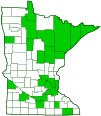oblong running spider
(Tibellus oblongus)
Conservation • Description • Habitat • Biology • Distribution • Taxonomy
Conservation Status |
|
|||||||
| IUCN Red List | not listed |
|||||||
| NatureServe | NNR - Unranked |
|||||||
| Minnesota | not listed |
|||||||
Description |
||
Oblong running spider is a medium-sized spider (order Araneae) but a large running crab spider (family Philodromidae). It occurs throughout Europe, Asia, and North America, and is common and locally abundant in Minnesota. It is by far the most common slender crab spider (genus Tibellus). It is found low on grasses and herbaceous plants in a wide variety of habitats. The body is long, slender, flattened, and hairy. Females are ¼″ to ⅜″ long and have a legspan of 11 ⁄16″ to 1″. Males are darker, more slender, and slightly smaller, ¼″ to 5 ⁄16″ in length. The covering (carapace) of the front part of the body (cephalothorax) is much longer than wide and has smoothly convex lateral margins. It is light brown to reddish-brown with a broad, dark brown median stripe, and a pair of narrower, faint, lateral stripes. The median stripe is forked at about the midpoint. The head is slightly angled upward. The eight eyes are black, equal in size, and arranged in two rows of four each. The back (posterior) row is strongly curved backward. The two inner eyes in the back row are closer to each other than to the lateral eyes. The abdomen is very long and cylindrical. It is light yellowish-brown to brown with dark brown markings. There is a broad, dark brown median stripe; a pair of narrower, faint, lateral stripes; and a small black spot near the end (apex) of each lateral stripe. Sometimes there are two black spots on each lateral stripe. The legs are long, slender, and the same color as the carapace. They do not have dark rings. The fourth (rear) pair is the longest and has three pairs of long spines on the underside of the fourth segment (tibia). |
||
Size |
||
Female Body Length: ¼″ to ⅜″ Male Body Length: ¼″ to 5 ⁄16″ Legspan: 11 ⁄16″ to 1″ |
||
Web |
||
|
||
Similar Species |
||
Habitat |
||
Wide range of habitats |
||
Biology |
||
Season |
||
May to September |
||
Behavior |
||
This spider does not produce a web to catch prey. It hunts actively, running after prey, and passively, lying in wait and ambushing prey. |
||
Life Cycle |
||
The female spins a nursery web for its eggs. It guards the web until the young spiderlings have dispersed. |
||
Food |
||
|
||
Distribution |
||||
|
Sources |
|||
| 5/26/2022 | ||||
Occurrence |
||||
Widespread in North America. Common and locally abundant in Minnesota. |
||||
Taxonomy |
|||
| Class | Arachnida (arachnids) | ||
Order |
Araneae (spiders) | ||
Suborder |
Araneomorphae (typical spiders) | ||
| Infraorder | Entelegynae | ||
Superfamily |
Thomisoidea (crab and running crab spiders) | ||
Family |
Philodromidae (running crab spiders) | ||
Genus |
Tibellus (slender crab spiders) | ||
Subordinate Taxa |
|||
oblong running spider (Tibellus oblongus maculatus) oblong running spider (Tibellus oblongus oblongus) |
|||
Synonyms |
|||
|
|||
Common Names |
|||
oblong running crab spider oblong running spider |
|||
Glossary
Carapace
The hard, upper (dorsal), shell-like covering (exoskeleton) of the body or at least the thorax of many arthropods and of turtles and tortoises. On crustaceans, it covers the cephalothorax. On spiders, the top of the cephalothorax made from a series of fused sclerites.
Cephalothorax
The front part of a spider’s body, composed of the head region and the thoracic area fused together. Eyes, legs, and antennae are attached to this part.
Tibia
The fourth segment of an insect leg, after the femur and before the tarsus (foot). The fifth segment of a spider leg or palp. Plural: tibiae.
Visitor Photos |
|||||
Share your photo of this arachnid. |
|||||
| This button not working for you? Simply email us at info@MinnesotaSeasons.com. Attach one or more photos and, if you like, a caption. |
|||||
Dan W. Andree |
|||||
Camouflaged Spider.... Not sure if this is a crab spider or some other kind. It was on some kind of seeding grass stalk. I didn’t see it at first because it was pretty small but did happen to see it move slightly. Amazing how camouflaged it is. Another wonder of nature I guess. |
 |
||||
Alfredo Colon |
|||||
 |
 |
||||
 |
|||||
MinnesotaSeasons.com Photos |
|||||
|
|||||

Slideshows |
||

Visitor Videos |
|||
Share your video of this insect. |
|||
| This button not working for you? Simply email us at info@MinnesotaSeasons.com. Attach a video, a YouTube link, or a cloud storage link. |
|||
Other Videos |
|||
| Tibellus - Crab Spider wetvideocamera |
|||
About
Published on Jan 31, 2011 A Tibellus spp. spider observed with prey in a flower near Slocan, BC. The prey appears to be a Syrphid hoverfly. Tibellus spp. possibly a Tibellus oblongus ? Slender Crab Spider |
|||


Created 11/30/2018
Last Updated:


